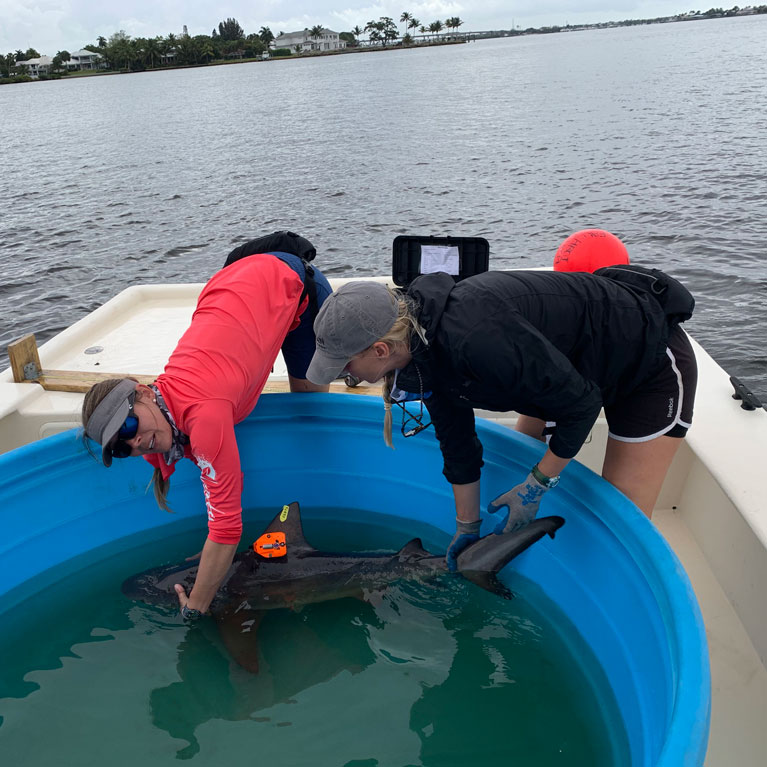Of algal blooms and bull sharks
Lauran is attaching accelerometers to juvenile bull sharks in the Indian River Lagoon in Florida, USA. This will help her monitor their body movement and behaviour in response to harmful algal blooms (HABs) in an important nursery area for these sharks.
I’ve loved water ever since I was a kid. Back in England, my parents used to struggle to get me out of the bathtub. When my dad was eight years old he watched a documentary about mountain gorillas and has loved them ever since. Like father, like daughter: when I was eight I watched a documentary about crocodiles and sharks and fell in love with them both. But quickly (after a week) I realised that my fascination for sharks and the ocean was more intense. I read all the books, watched all the documentaries and dragged my family around any...
Elucidating the response of juvenile bull sharks (Carcharhinus leucas) to harmful algal blooms
The study aims to establish the behavioral (shifts in activity budget/level and movement patterns) and energetic responses of immature bull sharks to HABs in the IRL. This will leverage current work being conducted at our lab, investigating biotoxin accumulation and distribution of this species after HAB events.
The International Union for the Conservation of Nature lists the bull shark as “near threatened”. There are conservation concerns for this species due to fisheries exploitation, low productivity, the depleted status of other large coastal sharks and anthropogenic disturbance at nursery sites. The IRL is an important nursery ground for bull sharks; their spatial and temporal distribution in the IRL has been assessed through capture and acoustic telemetry, with habitat use patterns inferred. This project is unique because it will:
1) provide the first fine-scale body movement data—which can be used to identify behaviors—of immature bull sharks under a) normal conditions and b) in response to a HAB event in the IRL;
2) when used in conjunction with acoustic telemetry can help link behaviors with particular locations/habitat types;
3) provide data that could be used to estimate field energy expenditure in the future.
Many factors contribute to the formation of HABs, such as nutrient loading and increased water temperature. Due to growing anthropogenic development and global climate change, these two contributing factors are on an upward trend and thus HAB events are likely to be more frequent. The IRL is an “estuary of national significance”, which serves as a spawning and nursery ground for many fish species, including elasmobranchs. Unfortunately, in terms of HABs, the IRL may be one of the most negatively impacted ecosystems in the US.
A recent survey (2016–2018) identified 16 elasmobranch species in the IRL, with immature bull sharks comprising 42% of the total shark catch. As predators, sharks influence the equilibrium of an ecosystem, often occupying high trophic levels and maintaining ecological balance through direct and indirect effects. Bull sharks are distributed throughout the IRL and are therefore likely integral to its ecosystem structure. Karenia brevis red tide blooms off Florida’s west coast have resulted in shark mass mortalities and changes to lemon shark brain neurochemistry. However, K. brevis tides are not common on the east coast of Florida, and the effects of other HABs on elasmobranchs, such as the toxic cyanobacterium Microcystis aeruginosa, are unknown. To avoid flooding, M. aeruginosa contaminated water from Lake Okeechobee is regularly discharged into the IRL where it can persist and grow. Whilst efforts are underway to understand the physiological effects of these HABs on elasmobranchs, we are unaware of any studies investigating the impact on fine scale behavior, which can impact ecosystem structure. We aim to elucidate these behavioral responses using animal-borne accelerometers.
We will assess whether there is a difference in fine scale activity/behavior (derived from animal-borne accelerometers) between free-ranging, immature bull sharks in normal conditions versus animals exposed to a harmful algal bloom, in the IRL.


